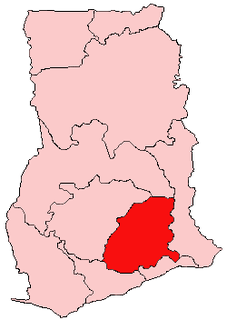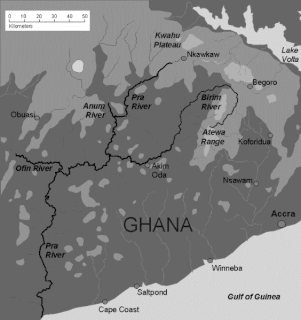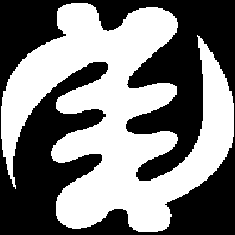Related Research Articles

Ghana is a West African country in Africa, along the Gulf of Guinea, just a few degrees north of the equator.
Osei Kofi Tutu I was one of the founders of the Ashanti Empire, aided by Okomfo Anokye, his chief priest and distant relative. The Asante are an Akan ethnic group of West Africa. Osei Tutu led an alliance of Asante states against the regional hegemon, the Denkyira, completely defeating them. Then, through force of arms and diplomacy, he induced the rulers of the other Asante city-states to declare allegiance to Kumasi, his capital. Throughout his career he was politically advised by Anokye, a cleric whose spiritual authority over the people aided in his founding of the empire.

The Mfantsefo or Fante are an Akan people. The Fante people are mainly located in the central coastal regions of Ghana. Over the last half centuries due to fishing expeditions, Fante communities are found as far as Gambia, Liberia and even Angola. Like all Akans, they originated from Bono state. Originally, "Fante" referred to "the half that left" and initially settled at Mankessim. Some of the states that make up the Fante are Agona, Kurantsi, Abura, Anyan, Ekumfi, Nkusukum, Ajumako and Gomoa. The Fante, like other related Akans, trace their roots to the ancient Sahara in the Old Ghana Empire. The Fante then migrated south to modern day Techiman in the Brong Ahafo region. It was from here that, legend say, their three great Leaders, Oson, Odapagyan and Obrumankoma led them south and separated from other Akans, to Mankessim.
Adansi is the name of one of the states in the Asanteman.
The Dyula are a Mande ethnic group inhabiting several West African countries, including Mali, Cote d'Ivoire, Ghana, and Burkina Faso.
The Akan are a meta-ethnicity living in the countries of present-day Ghana and Ivory Coast. The Akan language are a group of dialects within the Central Tano branch of the Potou–Tano subfamily of the Niger–Congo family. Subgroups of the Akan people include: the Agona, Akuapem, Akwamu, Akyem, Ashanti, Bono, Fante, Kwahu, Wassa, and Sefwi. Subgroups of the Bia-speaking Akan groups include the Anyin, Baoulé, Chakosi (Anufo), Sefwi (Sehwi), Nzema, Ahanta, and Jwira-Pepesa. The Akan subgroups all have cultural attributes in common; most notably the tracing of matrilineal descent, inheritance of property, and succession to high political office.
The diverse culture of Ivory Coast, a coastal West African country bordered by Ghana, Liberia, Mali, Burkina Faso, and Guinea, is exemplified by a multitude of ethnic groups, events, festivals, music, and art.

The Ashanti Region is located in south Ghana and is third largest of 16 administrative regions, occupying a total land surface of 24,389 km2 (9,417 sq mi) or 10.2 per cent of the total land area of Ghana. In terms of population, however, it is the most populated region with a population of 4,780,380 according to the 2011 census, accounting for 19.4% of Ghana's total population. The Ashanti Region is known for its major gold bar and cocoa production. The largest city and regional capital is Kumasi.

The Bono, also called the Brong and the Abron, are an Akan people of West Africa. Bonos are normally tagged Akan piesie or Akandifo of which Akan is a derivative name. Bono is the genesis and cradle of Akans. Bono is one of the largest ethnic group of Akan and are matrilineal people. Bono people speak the Bono Twi of Akan language. Twi language, thus the dialect of Bono is a derivative of a Bono King Nana Twi. In the late fifteenth century, the Bono people founded the Gyaaman kingdom as extension of Bono state in what is now Ghana and Côte d'Ivoire.

Kwahu refers to an area and group of people that live in Ghana, part of the Twi-speaking Akan group. The region has been dubbed Asaase Aban, or the Natural Fortress, in view of its position as the highest habitable elevation in the country. Kwahu lies in the Eastern Region of Ghana, on the west shore of Lake Volta. The region is shared with their fellow Akans: the Akyem and Akuapem, as well as the Adangbe-Krobos. A significant migrant population from the Northern and Volta Regions and some indigenous Guans from the bordering Oti and Brong East Regions live in the Afram Plains area. They work as traders, farm-hands, fisherfolk, and caretakers in the fertile waterfront 'melting pot'.
The Wangara are a subgroup of the Soninke who later became assimilated merchant classes that specialized in both Trans Saharan and Secret Trade of Gold Dust. Their diaspora operated all throughout West Africa Sahel-Sudan. Fostering regionally organized trade networks and Architecture projects. But based in the many Sahelian and Niger-Volta-Sene-Gambia river city-states. Particularly Dia, Timbuktu, Agadez, Kano, Gao, Koumbi Saleh, Guidimaka, Salaga, Kong, Bussa, Bissa, Kankan, Jallon, Djenné as well as Bambouk, Bure, Lobi, and Bono State goldfields and Borgu. They also were practicing Muslims with a clerical social class (Karamogo), Timbuktu Alumni political advisors, Sufi Mystic healers and individual leaders (Marabout). Living by a philosophy of merchantile pacifism called the Suwarian Tradition. Teaching peaceful coexistence with non-Muslims, reserving Jihad for self-defence only and even serving as Soothsayers or a "priesthood" of literate messengers for non-Muslim Chiefdoms/Kingdoms. This gave them a degree of control and immense wealth in lands where they were the minority. Creating contacts with almost all West African religious denominations. A group of Mande traders, loosely associated with the Kingdoms of the Sahel region and other West African Empires. Such as Ghana, Mali, Songhai, Yorubaland, Bono State, Kong, Borgu, Dendi, Macina, Hausa Kingdoms & the Pashalik of Timbuktu. Wangara also describes any land south of Timbuktu and Agadez. The Bilad-Al-Sudan or Bilad-Al-Tibr, "Land of Black" or "Gold."

The Pra River is a river in Ghana, the easternmost and the largest of the three principal rivers that drain the area south of the Volta divide. Rising in the Kwahu Plateau near Mpraeso and flowing southward for 240 km through rich cocoa and farming areas and valuable forests in the Akan lowlands, the Pra enters the Gulf of Guinea east of Takoradi. In the 19th century, the Pra served as the border between the Ashanti Confederacy and the Gold Coast.

The Akyem are an Akan people. The term Akyem is used to describe a group of four states: Asante Akyem, Akyem Abuakwa, Akyem Kotoku and Akyem Bosome. These nations are located primarily in the eastern region in south Ghana. The term is also used to describe the general area where the Akyem ethnic group clusters. The Akyem ethnic group make up between 3-4 percent of Ghana's population depending on how one defines the group and are very prominent in all aspects of Ghanaian life. The Akyem are a matrilineal people. The history of this ethnic group is that of brave warriors who managed to create a thriving often influential and relatively independent state within modern-day Ghana. When one talks of Ghanaian history, there is often mention of The Big Six. These were six individuals who played a big role in the independence of Ghana. Of the big six, people of Akyem descent made up the majority.
Akyem Abuakwa is one of the four states of Akyem in 14th century Africa. Currently, it is part of Ghana. Historically, the Akyem were part of the Adansi Kingdom, which was the first nation to build buildings out of mud. They were therefore were named Adansi (builders). In the 14th century, the Ashanti Empire emerged, and under the leadership of King Osei Tutu, defeated the Adansi and annexed them into the Ashanti Empire. The three Akyem nations that were part of the Adansi Kingdom seceded and crossed the River Pra.
Akwamu is a state set up by the Akwamu people in present-day Ghana. The capital of the Kingdom of Akwamu is called Akwamufie. After migrating from Bono state, the Akan founders of Akwamu settled in Twifo-Heman. The Akwamu led an expansionist empire in the 17th and 18th centuries. At the peak of their empire, the Akwamu created an influential culture that has contributed to Ghana.
Abusua is the name in Akan culture for a group of people that share common maternal ancestry governed by seven major ancient female abosom (deities). The Abusua line is considered to be passed through the mother's blood . There are several Abusua that transcend the different ethnic subgroups outside of the ancient seven. People of the same Abusua share a common ancestor somewhere within their bloodline, which may go back as far as thousands of years. It is a taboo to marry someone from the same Abusua. The different Abusua are the Agona (parrot), the Aduana (dog), the Asenie (bat), Oyoko (falcon/hawk), the Asakyiri (vulture), the Asona (crow), the Bretuo (leopard), and the Ekuona (bull).
The Ahanta/Ayinda are Akan People who live to the north and east of the Nzema. The Ahanta land has been historically known as one of the richest areas on the coast of what is now Ghana.
Agyen Kokobo (fl.c.1480-c.1500) was a southern Akan migrant leader in what is now Ghana. He is believed to have been the earliest leader and founder of the Akwamu kingdom, which he led from around 1480 to around 1500, possibly later. While serving as the Akwamu Chief, Agyen Kokobo ruled the state with his mother as the queen mother. Even today, rulers of the Akwamu kingdom still claim to be descendants of Agyen Kokobo; in the 1960s, one man claimed to be his 28th descendant.

The Komenda Wars were a series of wars from 1694 until 1700 largely between the Dutch West India Company and the English Royal African Company in the Eguafo Kingdom in the present day state of Ghana, over trade rights. The Dutch were trying to keep the English out of the region to maintain a trade monopoly, while the English were attempting to re-establish a fort in the city of Komenda. The fighting included forces of the Dutch West India Company, the Royal African Company, the Eguafo Kingdom, a prince of the kingdom attempting to rise to the throne, the forces of a powerful merchant named John Cabess, other Akan tribes and kingdoms like Twifo and Denkyira. There were four separate periods of warfare, including a civil war in the Eguafo Kingdom, and the wars ended with the English placing Takyi Kuma into power in Eguafo. Because of the rapidly shifting alliances between European and African powers, historian John Thornton has found that "there is no finer example of [the] complicated combination of European rivalry merging with African rivalry than the Komenda Wars."